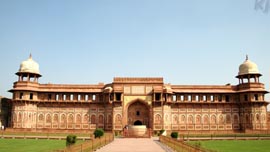Agra
Ever since Babur defeated and killed Ibrahin Lodi at Panipat in 1526, Agra played an important center of Mughal Empire. Akbar chose this city on the bank of River Yamuna as his capital and proceeded to build a strong citadel for the purpose. It is said that he destroyed the damaged old fort of Agra for the purpose and raised this grand group of monuments instead in red sandstone. Started in 1565, it took eight years and thirty-five lakh rupees to complete its construction and is second only to Taj in Agra. Qasim Khan Mir Barr-u-Bahr supervised the construction of this building.
TOURIST DESTINATIONS OF AGRA
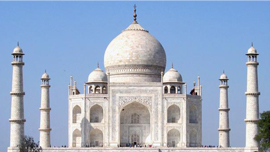
Taj Mahal
Taj Mahal, the epitome of love is the major attraction of people far and near. Whether one is Indian or non-Indian, seeing Taj Mahal is every traveler's dream. But what is this Taj Mahal ? Why was it picked as the seventh wonder of the world? What is special about Taj? Where is Taj located? How to reach it? Who should be credited for its existence? These are few questions which arise before and after you visit this all time marvel of the world.
Taj Mahal means "Crown Palace" and is in fact the most beautiful tomb in the world. The marble wonder is the largest and the most extravagant mausoleum built for the sake of love by a person. The grandeur & glory of Taj has reached every corner of the world. This timeless piece of art has been the inspiration for many artists and architects, ever since its creation. Its very difficult to adequately convey the legend in a picture or write in a piece of paper.
Akbari Mahal
The ruins of Akbari Mahal (meaning Akbar's Palace) are a testimony to the presence of the huge imperial courts surrounded by a series of spacious chambers. Set between Jehangiri Mahal and Bengali Burj, it was once part of a larger palace complex and was used for residential purposes. Built between 1565-69, it had a large stone paved courtyard enclosed on all sides by suites and chambers. One can still see the few suites on the eastern side of the courtyard that have survived the rigors of time.
One could enter it through the gateway on the western side, which was so designed that it ensured complete purdah and security for the women in the harem. There was a great Assembly hall with a high ceiling on the lower storey, which can still be seen but the upper storey is completely in ruins. It also had a hall with triple opening on the riverside.
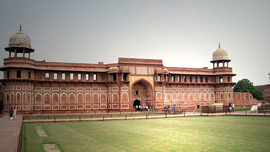
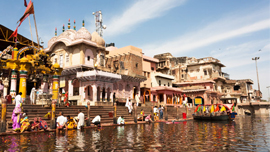
Mathura
Situated approximately 50 km north of Agra, and 150 km south of Delhi, the holy city of Mathura is the administrative centre of Mathura District of Uttar Pradesh. Known to be the birthplace of Krishna, it offers some of the nicest tourist attractions in India, like Jaigurudeo Temple, Dwarikadheesh Temple, Kans Kila and Vishram Ghat. It is a part of the great northern plains and is situated on the west bank of the river Yamuna. The climate of Mathura is extreme and tropical. Summers are extremely hot and winters are cold and foggy. It experiences southwestern monsoon rains from July to September.
The Shri Krishna Janmabhoomi (birthplace of Lord Krishna) is the main attraction of Mathura and an important pilgrim place of the Hindus. A stone slab marks the original spot of the birth of Lord Krishna. The earlier Kesava Deo temple had the room where Lord Krishna was born. According to legend, Lord Krishna was born in a small prison room where the tyrant ruler Kansa held his parents captive. The Archeological Museum of Mathura is an important place to visit. It houses an excellent collection of sculptures belonging to the ancient Mathura school of art. The Vishram Ghat, on river Yamuna, is another place to visit in Mathura. It is said that Lord Krishna had killed the tyrant Kansa here.
Anguri Bagh
Shah Jehan built Anguri Bagh or the Garden of Grapes in 1637. With Khas Mahal to its east and red sandstone arcades on the other three sides, it was the principal square of the zenana apartments or the living area of the royal ladies. There was a marble paved platform with a fountain in its centre and the garden itself was divided into compartments in intricate geometrical pattern. As the name suggests, this garden was known for harvesting choicest of grapes and flowers throughout the year.
It was designed to be a pleasant retreat or the paradise garden for the royal ladies and ensured their complete privacy. Hammams or imperial bathhouses adorned with exquisite wall paintings in royal blue and gold were located to its northeast. The tanks near the Jehangiri Mahal ensured the water supply to the ponds and baths of this garden.
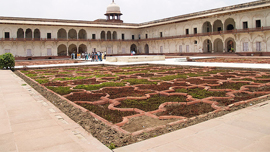
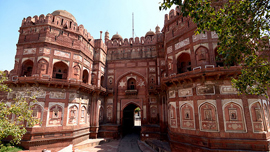
Delhi Gate Agra
Delhi gate is a famous monument in the city that is home to the Taj Mahal.The gateway is of red sandstone. The walls are 70 feet high and one mile and a half long. The Europeans and their followerstook refuge in the Fort during the Mutiny
The masterpiece of Akbar's time, Delhi Gate was built between 1568-69 to the western side of the fort and served as the principal gateway of the fort. It was purposefully designed to enhance the security of the fort. A wooden drawbridge was used to cross the moat and reach the fort from the mainland. Sharp curves, trap points and brick-paved ramp were devised to obstruct the path of the invading army. High and mighty bastions further strengthened the fort. Inside, there was another gateway by the name of Hathi Pol or Elephant-Gate. It was so named because of the two lifesize sculptures of elephants were erected here in such a manner that their upturned trunks made an archway. Today, one can see only the pedestals of these masonry elephants.
Diwan-i-am
Made in marble, this 'jharokha' with a three-arched opening and inlaid with precious stones, was known as the 'Takht-i-Murassa' (the Throne Room). This chamber was connected to the royal apartments and the royal ladies could watch the ceremonials of the Diwan-i-Am through the marble windows with perforated screens on the right and left of the enperor's chamber, while not being seen by those in the hall.
The marble dias below this chamber was known as 'Baithak'. It used to serve as the seat for Wazir, who presented petitions to the emperor. It is said that the hall used to have silver balustrades for the nobility, where they could stand according to their ranks and the outlines of the columns and the spandrels were done in gold.
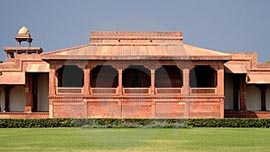
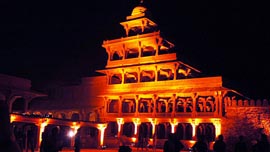
Fatehpur Sikri
Akbar was the greatest of all the Mughal rulers and one of the best to have ruled India. In 1556, he ascended the Mughal throne at the tender age of 14, after the sudden demise of his father, Humayun. As soon as he consolidated his power, he turned his attention towards building an imperial capital in Agra. The result was the Agra Fort, which not only served military purposes, but was also the royal residence.
Most of the buildings within the precincts of this magnificent Red Fort are a mixture of different architectural styles. The unique integration of these different styles has given the buildings and palaces within the fort a distinctive look. The assimilation of the different architectural styles was the reflection of the period of prosperity and social tolerance, which was the hallmark of Akbar's administration.
Jehangiri Mahal
Jehangiri Mahal is a stunning example of Mughal architecture at its best. Built between 1565-69, it has an impressive façade facing an open court to the west. It has an arched portal with two beautiful jharokhas, a series of ornamental arches and an octagonal tower on its either side. There is a complex arrangement of rooms, halls, corridors, galleries and verandahs in the palace, around a quare central courtyard.
The main portal leads to a square entrance hall with ribs-and-panels vaulted ceiling that takes one to identical annexes built on the northern and southern side of the palace and have beautiful Tibara dalans and side rooms. Built in red sandstone, the court showcases skillfully carved brackets supporting chhajja, a whispering gallery in the second storey and the jalied balustrade crowning each façade. A square chhatri on top of each façade looks quite impressive.
